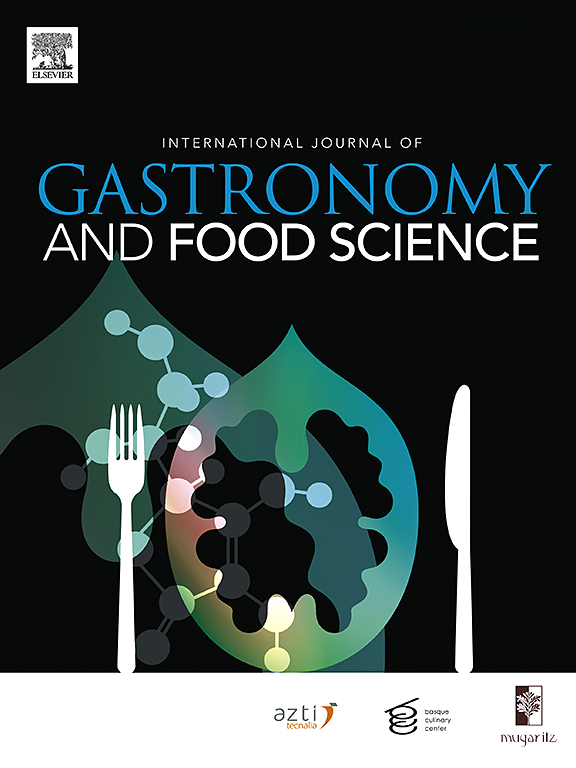新的北欧烹饪在实践:储存和保存做法的手段,为一个有弹性的餐厅部门
IF 3.2
2区 农林科学
Q2 FOOD SCIENCE & TECHNOLOGY
International Journal of Gastronomy and Food Science
Pub Date : 2025-05-06
DOI:10.1016/j.ijgfs.2025.101193
引用次数: 0
摘要
自从新北欧美食兴起以来,与当地、季节性、传统和可持续食品有关的理念已经渗透到瑞典餐饮业的部分领域,其中包括从过去的保存和储存实践中获得的灵感。然而,很少有人知道在餐馆的日常运营中如何进行保存和长期储存。因此,本文的目的是探讨NNC运动所强调的餐馆的保存和储存实践是否以及如何扩大规模,以支持向更具弹性和可持续性的酒店业过渡。通过与餐厅专业人士和批发商的访谈,确定机遇和挑战,它试图提供一个细致入微的理解,这些做法可以在加强北欧美食的食品安全和弹性方面发挥作用。虽然餐厅使用符合其美食哲学的保存方法来创造特定的风味和用餐体验,但进一步扩展这种做法有许多限制。这些挑战位于餐厅实践中,即“做餐厅”,更具体地说,物质和社会限制-à-vis存储空间,经济,招聘熟练员工,与发酵相关的风险以及长期保存和储存食物的感知相关性。我们认为,有了熟练的餐厅员工和获得食物的渠道,餐厅可以成为在当地规模上维持更具弹性的食物系统的重要角色。有了正确的激励措施,如果保存再次成为必要,餐饮业可以确保相关技能得到保留。本文章由计算机程序翻译,如有差异,请以英文原文为准。
New Nordic Cuisine in practice: Storage and preservation practices as a means for a resilient restaurant sector
Since the rise of the New Nordic Cuisine, ideas relating to local, seasonal, traditional and sustainable food has permeated parts of the Swedish restaurant sector, including inspiration from past preservation and storage practices. However, there is little knowledge of how preservation and long-term storage in general is practiced within restaurants’ daily operations. The aim of the article is therefore to explore if and how preservation and storage practices in restaurants, as emphasized by the NNC movement, could be scaled up to support a transition towards a more resilient and sustainable hospitality industry. By identifying opportunities and challenges through interviews with restaurant professionals and wholesalers, it seeks to provide a nuanced understanding of the role these practices can play in enhancing food security and resilience in the Nordic gastronomy. While restaurants use preservation methods in line with their gastronomic philosophy to create specific flavors and meal experiences, there are many constraints to expand such practices further. These challenges are located within the restaurant practice, i.e. “doing restaurant”, more specifically material and social constraints vis-à-vis storage space, economy, recruitment of skilled staff, the risks associated with fermentation and the perceived relevancy of preserving and storing food for long-term use. We argue that with skilled restaurant personnel and access to food, the restaurant could become an important actor for maintaining a more resilient food system at the local scale. With the right incentives, the restaurant sector could ensure that the relevant skills are maintained if preservation once again should become a necessity.
求助全文
通过发布文献求助,成功后即可免费获取论文全文。
去求助
来源期刊

International Journal of Gastronomy and Food Science
Social Sciences-Cultural Studies
CiteScore
5.30
自引率
10.50%
发文量
170
审稿时长
45 days
期刊介绍:
International Journal of Gastronomy and Food Science is a peer-reviewed journal that explicitly focuses on the interface of food science and gastronomy. Articles focusing only on food science will not be considered. This journal equally encourages both scientists and chefs to publish original scientific papers, review articles and original culinary works. We seek articles with clear evidence of this interaction. From a scientific perspective, this publication aims to become the home for research from the whole community of food science and gastronomy.
IJGFS explores all aspects related to the growing field of the interaction of gastronomy and food science, in areas such as food chemistry, food technology and culinary techniques, food microbiology, genetics, sensory science, neuroscience, psychology, culinary concepts, culinary trends, and gastronomic experience (all the elements that contribute to the appreciation and enjoyment of the meal. Also relevant is research on science-based educational programs in gastronomy, anthropology, gastronomic history and food sociology. All these areas of knowledge are crucial to gastronomy, as they contribute to a better understanding of this broad term and its practical implications for science and society.
 求助内容:
求助内容: 应助结果提醒方式:
应助结果提醒方式:


